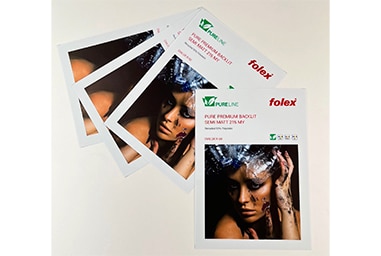The Folex Group is striving to make its business activities as environmentally and climate-friendly as possible – even if this poses a particular challenge in film finishing. With a recently adopted transformation concept for more resource-efficient, less polluting and more climate-friendly production, the company aims to reduce its CO2 emissions by 40 per cent by 2030 and achieve climate neutrality by 2045.
In order to put its endeavours to be environmentally and climate-friendly on a valid basis, Folex has drawn up CO2 balances for all sites in recent years based on the ‘Greenhouse Gas (GHG) Protocol’. This internationally recognised tool divides greenhouse gas emissions into three categories or ‘scopes’: Scope 1 includes direct emissions from sources that are controlled by the company. Scope 2 includes indirect emissions associated with the generation of electricity, heat, steam or cooling consumed by the company. Scope 3 includes all emissions that arise in a company’s value chain but are not controlled by the company.
The Folex transformation concept describes the complex path to climate neutrality, which will take years. This was initially developed for Folex Coating GmbH in Cologne in collaboration with Rudolphi Energieeffizienz from Much and will be transferred to the other Folex Group sites in Schwyz and Erlangen in a further step. In addition to extensive measures to reduce emissions, it initially includes the development of an energy controlling system with the aim of enabling valid CO2 balancing down to plant and product level.
All emissions were systematically analysed as the basis for the transformation concept, with Scope 3 emissions not being the focus for the time being due to a lack of external data. Although the aim here is also to reduce consumption, the transformation measures are focussed on reducing Scope 1 emissions:
Optimisation of production
The focus is on the coating process and exhaust air treatment, which generate the majority of all emissions. The aim here is to achieve a significant reduction by optimising the processes and system hardware.
Significant reduction in the use of solvents
Solvent-based formulations should be replaced by water-based systems wherever possible. This reduces both direct and indirect emissions in exhaust air treatment. However, intensive development work is still required here in order to fulfil the diverse requirements for product properties with solvent-free formulations.
Conversion of the vehicle fleet to e-mobility
Due to the current charging infrastructure and ranges of e-cars, the majority of company cars are powered by combustion engines. A gradual switch to e-mobility will take place over the next few years. In anticipation of corresponding advances in charging infrastructure and battery technology, Folex assumes that the vehicle fleet can be almost completely converted to e-mobility by 2030.
Use of district heating
Heating oil or gas is currently still used to heat some of the buildings. These energy sources will be replaced by climate-neutral district heating or comparable solutions.
The sustainable PureLine product range from Folex
With the products in the PureLine programme, Folex wants to make a contribution to the careful use of resources and the reduction of plastic waste. For example, the new Dialux® R-50 backlit film for water-based and latex inks is based on polyester with 50% post-consumer recycled content. The REGU® Pure Active Release 200 roll-up film utilises split-and-recycle technology for coated display films. By removing the printed graphics together with the coating, 65% of the roll-up film becomes pure, perfectly recyclable plastic.
Folex
The Folex Group, with production companies in Switzerland and Germany (Cologne and Erlangen), specialises in the finishing and coating of films and special media and offers high-quality products and customised services for a wide range of markets. The Folex product world includes solutions for many sectors – from the printing industry to digital and large-format printing, the office and home sector, through to preliminary products for the electronics industry.

